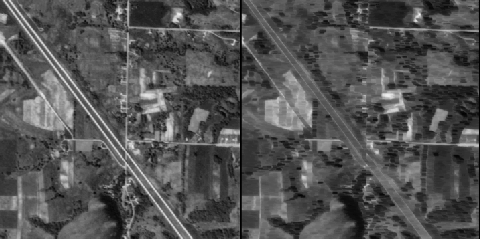ERODE Function
Implements the morphologic
erosion operator for shape processing.
Usage
Input Parameters
Returned Value
Keywords
Discussion
Background Information
TIP: Erosion can be used to change the morphological structure of objects or features in an image to see what would happen if they were to actually shrink over time.
Used with gray scale images, which are always converted to a byte type, the ERODE function is accomplished by taking the minimum of a set of differences. It may be conveniently used to implement the neighborhood minimum operator, with the shape of the neighborhood given by the structuring element.
Used with binary images, the origin of the structuring element is moved to each pixel of the image. If each nonzero element of the structuring element is contained in the image, the output pixel is set to one.
Letting A 
 represent the erosion of an image A by structuring element B, erosion may be defined as:
represent the erosion of an image A by structuring element B, erosion may be defined as:

where (A)-b represents the translation of A by b. The structuring element B may be visualized as a probe which slides across the image A, testing the spatial nature of A at each point. Where B translated by i, j can be contained in A (by placing the origin of B at i, j), then Ai, j belongs to the erosion of A by B.
Example 1
Example 2
img = ERODE(aerial_img, struct, /Gray)
Because the ERODE function was applied to the image three times, the "blurring" is more pronounced that it would have been with only one erosion.
Figure 2-33 The ERODE function has been used to "wear away" the visual elements of this 512-by-512 aerial image.

Figure 2-34 The ERODE function has been used to "wear away" the visual elements of this 512-by-512 aerial image.
See Also



doc@boulder.vni.com
Copyright © 1999, Visual Numerics, Inc. All rights
reserved.
 The array to be eroded.
The array to be eroded. The structuring element. May be a one- or two-dimensional array. Elements are interpreted as binary (values are either zero or nonzero), unless the Gray keyword is used.
The structuring element. May be a one- or two-dimensional array. Elements are interpreted as binary (values are either zero or nonzero), unless the Gray keyword is used. (optional) The x-coordinates of structure's origin.
(optional) The x-coordinates of structure's origin. (optional) The y-coordinates of structure's origin.
(optional) The y-coordinates of structure's origin. Nx / 2
Nx / 2 ,
, 
 represent the erosion of an image A by structuring element B, erosion may be defined as:
represent the erosion of an image A by structuring element B, erosion may be defined as:




